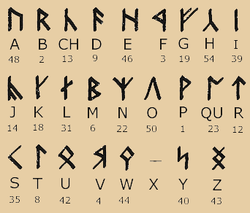
Khuzdûl,[1][2] also known as Dwarvish, was the language of the Dwarves, written in the 50-letter Cirth script (Runes). It appears to be structured, like real-world Semitic languages, around the triconsonantal roots: kh-z-d, b-n-d, z-g-l.
History
The language was created by the Vala Aulë, creator of the Seven Fathers of the Dwarves, who taught them "the language he had devised for them" unrelated to the languages of the Elves.[3][4] The language was rarely heard by outsiders and was a secret, and was thus not recorded by Elves or Men. The Dwarves also had a language of silent gesture-signs known as Iglishmêk.[5]
In the early days of Middle-earth, before Men entered Beleriand, they had contact with the Dwarves of the Blue Mountains and further East, and the Taliska language was devised, similar to the Dwarven tongue. Taliska would be the ancestor of Adûnaic, the later tongue of Númenor, and of the Common Speech.
The only Khuzdûl line in J.R.R. Tolkien's primary writings is Gimli's battle-cry "Baruk Khazâd! Khazâd ai-mênu!", meaning, "Axes of the Dwarves! The Dwarves are upon you!".
Conceptual history
The Lhammas tells that Khuzdûl was uniquely derived from a separate language family called Aulëan, devised by Aulë the Smith, the Vala who created the Dwarves. Khuzdûl is unique in belonging to Aulëan, unlike the languages of Elves and Men, which are of the Oromëan language family.[6]
Background
Khuzdûl was largely inspired by Semitic languages. In fact, Tolkien wanted it to sound much like Hebrew, and noted that both Jews and his Dwarves were "once natives and aliens in their habitations, speaking the languages of the country, but with an accent due to their own private tongue".[7] Another reason Hebrew was chosen as a basis for Khuzdûl is that it is unlike any European languages, equivalent to the contrast between Dwarven speech and Elvish languages. Although Dwarven symbols were identical to Germanic Runes, the symbols that correlate to specific English letters have been mixed around, and a few runes are inverted.[8]
Neo-Khuzdûl
Neo-Khuzdûl is the conventional name of various attempts of expand the Khuzdûl language invented by J.R.R. Tolkien.
Because in lore the Dwarves don't use their own language with the outsiders, Khuzdûl is very poorly attested throughout Tolkien's writings. For this reason the scholars that attempted to reconstruct Khuzdûl necessitated to create a wholly original vocabulary and grammar rules, mostly based on Semitic languages, and Hebrew in particular. In the 2000's, linguist David Salo created an expanded Dwarvish vocabulary used in Peter Jackson's films. For The Hobbit film trilogy. In particular, in The Desolation of Smaug he fashioned Thorin's insult to Thranduil, "îsh kakhfê ai-‘d-dûr-rugnul", meaning "May I urinate upon the naked-jawed [unbearded Elves]", based off of Gimli's Extended Scene insult to Haldir in The Fellowship of the Ring, "Ishkhaqwi ai durugnul", which merely meant "I spit on your grave".
The website "The Dwarrow Scholar" holds an entire fan-expanded Neo-Khuzdûl lexicon that surfaced in 2012.[9]
Translations
| Foreign Language | Translated name |
| Greek | Κχουζντούλ |
| Hebrew | קהוזדול |
| Japanese | クズドゥール |
| Persian | خوزدول |
| Russian | Кхуздул |
References
- ↑ The History of Middle-earth, Vol. 12: The Peoples of Middle-earth, X: "Of Dwarves and Men", pg. 321 (footnote 19)
- ↑ Vinyar Tengwar, Number 48, "Eldarin Hands, Fingers & Numerals and Related Writings — Part Two", pgs. 6, 24
- ↑ The Silmarillion, Quenta Silmarillion: "Of the Sindar"
- ↑ The Lord of the Rings, Appendix F, "The Languages and Peoples of the Third Age", "Of Other Races"
- ↑ The History of Middle-earth, Vol. XI: The War of the Jewels, Part Four: "Quendi and Eldar", pgs. 395, 402
- ↑ The History of Middle-earth, Vol. V: The Lost Road and Other Writings, chapter VII: "The Lhammas"
- ↑ The Letters of J. R. R. Tolkien, Letter 176
- ↑ The Letters of J. R. R. Tolkien, Letter ?
- ↑ dwarrowscholar.com